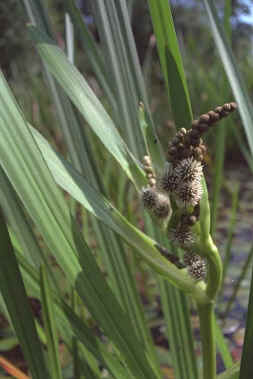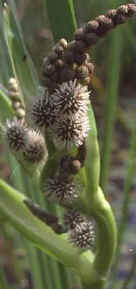Information on Selected Wetland Species
Branched Bur-reed
Sparganium erectum L.

| Habitat | This emergent
plant grows by still or slowly flowing water. It is easily uprooted and therefore is not
found on exposed shores or by rapidly moving water. It occurs in narrow bands in permanent
water at the edge of lakes, rivers, streams, canals and ditches. It may occur in swamps or
ponds which are silting up. This species cannot withstand prolonged emersion from the
water. It is found over a wide range of fine, often anaerobic mineral substrates, in mesotrophic to eutrophic
conditions. It is very tolerant of eutrophic conditions. The optimum depth for this
species is 10-20cm, although it will flower and fruit at depths of up to 1m. The plants are palatable to cattle, so it is vulnerable to grazing. It may also be eliminated by summer cutting. This is primarily a lowland species. Water plantain is a frequent associate. |
|
| Structure | Branched Bur-reed is a perennial, growing to a height of about 1.5m. The leafy stems
arise from a corm, as do slender stolons
or rhizomes. The leaves and corm die back over the winter,
being replaced from the tip of remaining rhizomes. The leaves begin to grow in April. They
are very markedly keeled. There are four subspecies in Britain differing in the shape of
the fruit. Unbranched Bur-reed (Sparganium emersum) grows in deeper water than Branched Bur-reed. It has narrower leaves which float on the water surface and unbranched flower spikes. |
|
| Reproduction |  |
The flowers are borne in inflorescences on emergent shoots, from July to September. The flowers are unisexual, although the plants themselves are bisexual. The flowers are aggregated into compact male and female heads, with the male heads being above the female heads on the same inflorescence. All the flowers in an individual head mature together, with the male heads maturing after the female heads. Plants can be both self-pollinated and wind-pollinated. Insects visit male flowers, but rarely female ones, so that insect pollination is not important. |
| Dispersal | Fruits can be found up until
November. They can float for several months and have a water-repelling surface. The seeds
can be dispersed by moving water and possibly also by boats and water birds. The seeds germinate under water producing submerged juvenile leaves. Seedling mortality can be very high, particularly in cloudy water and plants rarely become established from seed. Vegetative spread is accomplished by growth from rhizomes and detached rhizomes or uprooted plants. |
|
| Geographical Range |
Widespread throughout Britain and Ireland. This species is also found in temperate regions of Europe, N. Africa and Asia, as far east as Japan. It also occurs in western North America and in Australia. | |
Sources of Information
Aquatic Plants in Britain and Ireland. C.D. Preston and J.M. Croft. Harley Books, 1997.
British Water Plants. S. Haslam, C. Sinker and P. Wolseley. The Field Studies Council 1975 (1982 ed.)